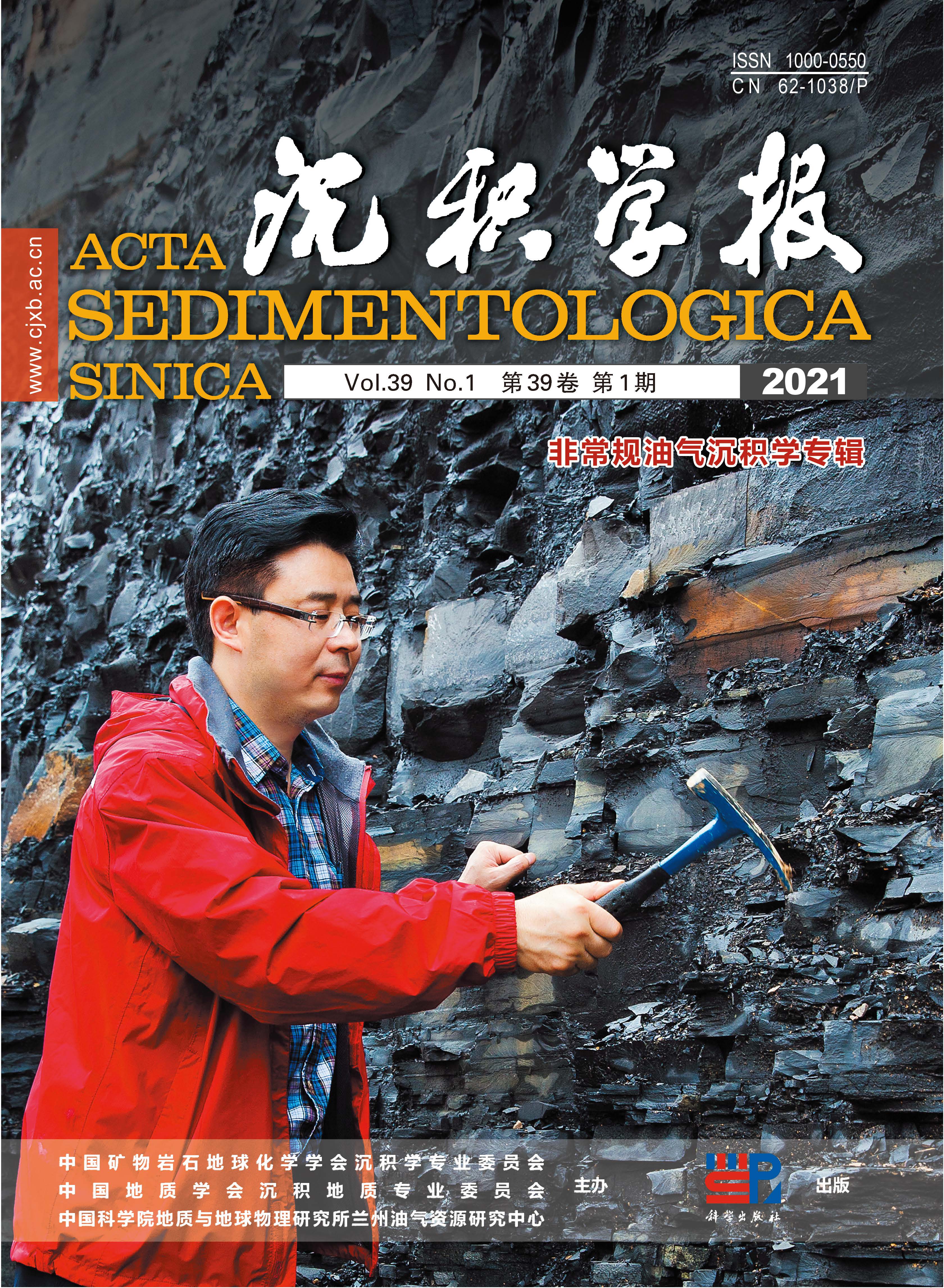HTML
-
混合沉积作为一种相对特殊的沉积类型,对于了解其沉积动力学及恢复沉积过程等有着特殊的意义,其产物通常是由硅质碎屑、碳酸盐等两种及多种组分组成的混合沉积物,且在结构构造及形成机理等方面均与单一组分的沉积物有一定差别。众所周知,形成碳酸盐沉积物的有利条件之一是清澈的水体,而硅质碎屑岩与火山碎屑岩等物质的注入会对碳酸盐岩沉积造成一定的影响,即在大多数情况下,碳酸盐沉积物不会和其他类型沉积物混合在一起。而受这种思想的影响,以往学者多对相对较纯的硅质碎屑与碳酸盐沉积物的分类、沉积相等方面较为关注[1-4],而将混合沉积视为相对“小众”的沉积类型而少有研究,直到20世纪50年代才提出这种沉积类型形成的假设条件,即无明显的水深差异,灰岩和泥岩是可以共存的[5]。硅质碎屑岩与碳酸盐岩并不是两个完全不同的领域,相反他们属于一个连续统一体[6],混合沉积物正是处于他们之间而广泛存在,但混合沉积的发生需要在陆源供应和碳酸盐生产之间取得平衡的状态下进行[7]。国内外学者开始利用岩芯、钻井、测井、地震等资料,以及对现代沉积、古代露头等考察对混合沉积开展研究,研究内容包括混合沉积物的岩石类型及其划分[8-12]、沉积过程及主控因素分析[13]、非均质性[7,14]、油气勘探研究[15-18]等方面,近些年的研究发现也证明了混合沉积是一种非常普遍的现象[19-42]。目前国内外多是对硅质碎屑—碳酸盐混合沉积物有所研究,而对由火山碎屑、硅质碎屑、碳酸盐等多组分组成的混合沉积物研究相对较少。国外学者多对滨浅海混合沉积环境开展研究,而国内学者多对陆相湖泊混合沉积开展研究。本文在对国内外混合沉积研究调研的基础上,结合吉木萨尔芦草沟组混合沉积相关研究工作,对混合沉积物及其相关概念、沉积环境及沉积相类型、非均质性、混合沉积形成过程与主控因素、混合沉积油气地质意义等几个方面的研究进展进行了梳理总结,并提出了目前混合沉积所面临的问题及展望。
-
“混合沉积物”(Mixed sediments)一词最早来源于Mount[13]的研究报道,包含了碳酸盐沉积物与硅质碎屑沉积物在沉积结构方面的混合,而不包括层序上纯碳酸盐岩与硅质碎屑岩的间互。国内关于“混合沉积”最早是张锦泉和叶红专[43]定义的,其对“混合沉积”一词的描述也是限于碳酸盐及陆源碎屑之间,可以是由碳酸盐和陆源碎屑结构混合组成的混积物和“纯”碳酸盐或碎屑沉积物中的相互夹层或者二者的互层以及横向相变的混合沉积组成,此中所提及“混合物”一词,与Mount[13]提出的“混合沉积物”一词词义相近。杨朝青等[9]提出“混积岩”一词在国内也被广泛使用,其泛指陆源碎屑岩与海相碳酸盐岩(不包括胶结物)这两种沉积物混合而成的岩石,黏土矿物可有可无。沙庆安[44]将混合沉积分为狭义的和广义的,狭义的是指在同一岩层内陆源碎屑与碳酸盐组分的混合,而广义的混合沉积则包括了狭义的和陆源碎屑与碳酸盐层构成交替互层或夹层的混合。郭福生等[45]类比“浊积岩”、“风暴岩”等能够反映特殊沉积事件的名词,认为“混积岩”一词能够强调其特殊的成因意义,因此有必要提出这一概念,并将这种互层和夹层组合命名为“混积层系”,认为混积层系和混积岩一起构成了广义的混合沉积。李祥辉[46]通过对前人“混合沉积岩”、“混合沉积层系”概念的分析,认为国内这两种概念具有欠缺之处,建议混合沉积岩概念定义为“在同一沉积环境下形成的硅质碎屑与碳酸盐两种组份结构成份上相互混杂和交替出现的沉积物”,而不单指同一层内。综合以上对混合沉积物及其相关概念的分析,本文认为狭义的混积岩或混合沉积含义要包含两个方面:一是岩石组分的混合,不仅限于常见的硅质碎屑组分与碳酸盐组分的混合,也包括硫酸盐、黏土、火山碎屑等其他组分;二是这种混合能够表征两种或多种异相组分在时间和空间上沉积的同时性。而广义的混合沉积,除包含上述狭义的混合沉积,还包含混积层系,混积层系含义也包含两个方面:一是尺度方面,包含从岩相尺度至地层尺度;二是这种混合要与沉积过程、气候变化和或相对海平面变化相关[7]。
-
非均质性一词常用于描述储层的地质复杂性,以及这种复杂性与流经储层的流体流动之间的关系[47]。沉积物中岩性及粒度变化等引起的孔隙度与渗透率的分布决定了储层的非均质性[48]。储层非均质性因成岩作用和岩石的机械变形而进一步复杂化,与碎屑岩相比,混合沉积物由于更多的压实和胶结作用而遭受更迅速和广泛的孔隙度损失[49],虽然高孔隙度可能与深埋混合沉积地层中碳酸盐颗粒的溶解有关[16]。此外,原生孔隙与次生孔隙受碳酸盐颗粒与硅质碎屑颗粒混合比例的控制[16,49]。控制储层特征的两个主要岩石特性是孔隙度和渗透率,这两者又严格取决于原始沉积物的结构和成分的影响,混合沉积物的组成控制着沉积物内部的沉积结构[33],通过对吉木萨尔凹陷芦草沟组岩芯常规孔渗数据分析,表明粉砂—细砂岩、云质粉砂岩及砂屑云岩物性相对较好,为甜点储层的主要岩性,泥质含量增多使得物性变差,白云石含量增多可提高岩石的脆性,有利于后期的储层改造[50-51]。
混合沉积的类型与规模对储层特征有重要影响,不同类型的混合沉积储层对水淹程度、产能的影响不同[14]。对于不同尺度、不同类型的混合沉积,都存在着不同程度的非均质性。狭义组分混合型混合沉积包含纹层状混合沉积(图1a~c)与块状混合沉积(图1d~f)两种类型,纹层状混合沉积不同组分间呈纹层状间互,块状混合沉积不同组分间呈大面积均匀分布。组分混合沉积非均质性受岩石颗粒的类型与排列方式、孔隙大小与形状等因素控制,除此之外纹层状混合沉积还受不同组分纹层厚度与间互密度的影响。广义混积层系尺度包含了从岩相尺度混积层系(图2)至地层尺度混积层系,其非均质性在垂向上的变化更为明显。
-
混合沉积在各种沉积环境中有着广泛的分布,本文在前人对不同地区混合沉积研究的基础上,总结梳理了混合沉积形成的各类沉积环境。
-
海相沉积环境水体盐度高,碳酸盐岩较为发育,是混合沉积较为发育的沉积环境之一。根据海底地形和海水深度,以及陆棚区地形、水深、潮汐和波浪作用的特点,可将海洋沉积环境细分为滨海、浅海、半深海和深海4种环境[52]。由于半深海与深海环境对于混合沉积形成机制相似,故本文将这两种沉积环境一起讨论。
-
滨海沉积位于最大风暴潮线与浪基面之间,可细分为临滨(潮下带)、前滨(潮间带)、后滨(潮上带)、海岸沙丘等亚沉积环境,受波浪和潮汐作用影响,各亚环境水动力强弱有差异,但整体属强水动力沉积环境。潮下带、潮间带等具有大潮差的环境常发育硅质碎屑—碳酸盐混合沉积[53-54]。滨、浅海相带的混合沉积,可成为优质储层和烃源岩的勘探靶区[17]。
-
浅海环境是混合沉积发育较为常见的环境之一[13,55-58]。早期Mount[13]以浅海陆棚沉积为基础,分析了4种混合沉积类型的形成过程及其相应的控制因素。受陆架远端甚至海洋的影响,浮游生物富集,而碎屑流注入来自于陆架上部,陆架的中部是碳酸盐—硅质碎屑混合沉积主要沉积环境[58]。
-
较深的水体对碳酸盐岩沉积是一项不利因素,而李祥辉[46]认为混合沉积环境不应只限定为浅海环境,碳酸盐补偿深度(CCD)之上的深海环境以及斜坡和深海扇环境都可能发生混合沉积作用。董桂玉等[59]对湖南石门杨家坪下寒武统杷榔组三段混合沉积物进行研究,并判定其形成于深水斜坡环境,对于深水—区域如深水斜坡区,也有混合沉积的发现。
-
过渡地带处于陆源碎屑供应与碳酸盐沉积物的交锋地带,混合沉积也有发现[57,60],且多属于相混合沉积类型。孙娇鹏等[60]以柴东北缘古生代为例,开展了位于潮坪—碳酸盐岩台地—欠补偿盆地沉积环境的混合沉积研究,分析了碎屑岩—碳酸盐岩混积相的发育特征,并总结了平面相组合发育模式。叶茂松[61]以环渤中坳陷古近系沙河街组一、二段为例,研究了扇三角洲前缘(包括水下碎屑流与河口坝)、前扇三角洲等过渡相沉积环境的混合沉积特征、内部构成及成因解释,并且建立了扇三角洲重力流驱动混合沉积模式、扇三角洲建设—废弃互层型混合沉积模式。
-
常见的混合沉积物多由硅质碎屑组分与碳酸盐组分混合形成,这就要求必须有形成硅质碎屑岩和碳酸盐岩的环境,或者存在两者的来源,而陆相沉积环境中除湖泊沉积环境外,很难形成碳酸盐岩沉积,前人关于陆相混合沉积也多集中在湖泊沉积环境中,故本文对于陆相混合沉积环境的讨论主要是湖泊沉积环境。
湖泊是我国广泛发育的一种沉积类型,其规模也相差悬殊,大型湖泊的环境特点与海洋有一定相似之处,也有一定区别,相比于海洋沉积,湖泊沉积受构造与气候活动的影响更为明显,受控因素更多。以湖泊与海洋间连通关系,可将湖泊分为闭塞型、开阔型、半闭塞—半开阔型;以水体含盐度可将湖泊分为淡水湖泊与咸水湖泊;以湖泊所处区域的构造活动特点,可分为断陷型、坳陷型、断—坳转化型。湖泊中发育的混合沉积主要受构造和气候控制[43],碎屑物质供给量、水体盐度、水动力条件、风场等因素对混合沉积形成也有一定控制作用。
目前国外对于海相混合沉积的研究居多,国内则多偏向于陆相湖泊混合沉积的研究[62-72]。陈世悦等[71]对东营凹陷古近系沙河街组混合细粒沉积物进行研究,认为湖相深水细粒混合沉积既有物质成分上的混合,还包含纹层叠置、不均匀团块等结构上多尺度的混合,而纹层叠置混合沉积是断陷湖盆最主要的混合方式,气候与水动力是控制湖相细粒混合沉积物的主要因素。混积型滩坝是湖相混合沉积中重要的沉积微相类型之一,叶茂松[61]对环渤中坳陷古近系沙河街组一、二段滩坝混合沉积复合体研究时,共识别出含生物砂质碎屑滩坝、砂质鲕粒滩坝、砂质钙藻滩坝、砂质生物碎屑滩坝与泥晶滩坝等五种滩坝混合沉积类型,并分析了每种混合沉积滩坝类型的内部构成及其成因解释。混合沉积滩坝储层往往也具有相对好的物性条件,在致密油储层中常作为甜点区[68-69,72]。
3.1 海相沉积
(1) 滨海沉积
(2) 浅海沉积
(3) 半深—深海沉积
3.2 过渡相沉积
3.3 陆相沉积
-
Mount[13]以镶边台地沉积背景将混合沉积过程分为间断混合、相混合、原地混合与母源混合四种类型,之后国内外学者在此基础上,补充完善了适合于各自研究区块的混合沉积模式。
-
Mount[13]将由高强度的间歇事件引发形成的混合沉积称之为间断混合。他以镶边台地为沉积背景,介绍了间断混合型混合沉积过程(图3),风暴等引起海平面升降,在最大风暴潮线附近,海水侵蚀珊瑚礁或浅滩复合体的沉积物,并将它们重新沉积在以硅质碎屑为主的泻湖环境中,形成混合沉积物;风暴还可将潮下带陆源碎屑泥质沉积物与灰(云)泥携带至潮坪处形成混合沉积物,这些混合沉积物的沉积构造既受风暴流输送物质的控制,也受原沉积环境的控制。

Figure 3. Discontinuous mixed deposition under the background of rimmed platform[13]
间断混合沉积环境广泛,作用方式多样,Tucker[73]在对挪威南部晚前寒武纪潮下带混合沉积物研究中发现了细粒石英砂岩,分析其是由风暴潮从近岸搬运至潮下环境中。Halfar et al.[74]通过对墨西哥南方加利福尼亚湾温暖环境的现代碳酸盐—硅质碎屑混合沉积进行研究,发现这种混合现象是由于短期风暴或飓风事件所导致的间断性搅拌所致。杨朝青等[9]通过对云南曲靖中泥盆统曲靖组的混合沉积物构造、组分、沉积环境等研究,认为其是由风暴引起的海洋近岸地带间断混合沉积。丁一等[66]通过对川中龙岗地区下侏罗统混合沉积的研究,发现纵向剖面结构上,风暴介壳和风暴砂可以叠置于任何浅湖—半深湖微相之上,表明了风暴沉积的随机性。
-
依据瓦尔特相序定律,在横向上碳酸盐岩相与硅质碎屑岩相之间过渡区域,在垂向上会形成混合沉积[13]。这种混合沉积范围广泛,在礁前、礁后、礁间沉积环境,潮坪等近岸地带与潮下带之间沉积环境(图4),例如:1)遮蔽硅质碎屑型泻湖的碳酸盐岩滩复合体一侧;2)硅质碎屑潮坪临近潮下带碳酸盐岩沉积物区域;3)接受风成作用供给不同成分的海岸沙丘与潮坪;4)位于火山岛侧向的生物碎屑浅滩,接受来自邻近地区的火山碎屑沉积物;5)硅质碎屑沙丘广泛分布的潮汐海峡处,居住着很多钙质骨架生物。加利福尼亚湾的La Paz地区临近浅海湾与中陆架环境,碳酸盐岩层与硅质碎屑层交互沉积[36]。这种相混合类型既可以产生组分混合的混合沉积物也可以产生地层尺度的混积层系。

Figure 4. Facies mixed deposition under the background of rimmed platform[13]
据Mount[13]研究中描述本应该渐变且广泛存在的相混合沉积,观察到的却多为突变型相混合沉积,分析其原因为浅海陆架地区相变是由于陆架坡度等沉积条件的改变,所以碳酸盐与硅质碎屑沉积相间多为突变接触,而渐变型相混合更好地记录了横向上沉积相的迁移变化。
叶茂松[61]在对环渤中坳陷沙河街组混合沉积研究时,提出了扇三角洲重力流驱动混合模式与扇三角洲建设—废弃互层型混合模式。前者是在重力流的驱动下将近岸或浅湖区原生沉积的生物碎屑颗粒,搬运至扇三角洲前缘及前扇三角洲处形成混合沉积,如果考虑到重力流的形成机制,也可将其划分至间断型混合沉积类型。后者受陆源碎屑供给的影响形成建设—废弃互层型扇三角洲混合沉积。这两种混合沉积模式都可归类为相混合沉积。
-
在硅质碎屑沉积背景下,与原地或准原地死亡的钙质生物组合所组成的混合沉积称为原地混合。由于其形成过程包含了局部原地形成的沉积物,故称之为原地混合沉积。原地混合最常见于潮下陆源泥岩环境,在这些环境中,软体动物、有孔虫、苔藓虫、腕足类、棘皮动物和钙质藻类等生物,在穴居生物和弱潮汐作用下,与陆源泥混合在一起(图5)。

Figure 5. In situ mixed deposition in the background of rimmed platform[13]
原地混合多发育组分混合的混合沉积物。多米尼加共和国Cibao盆地硅质碎屑陆架内的碳酸盐沉积物,以及意大利南部第四纪的混合沉积物均属于原地混合沉积类型[33,36-37,39,75]。此外,藻类能够产生碳酸钙并且捕捉碎屑物质,也属于原地混合[13],当湖流、沿岸流所携带的陆源碎屑物质不足以抑制藻类生长时,藻类分泌的钙质或者促使水介质沉淀出钙质并黏结吸附碳酸盐,也能捕获粉砂、黏土等陆源碎屑物质以及火山碎屑物质等从而形成混合沉积物。有学者认为这种藻混合沉积类型可单独划分为一种混合沉积类型[76],笔者认为其仍应该属于原地混合类型。
-
Price[77]通过对希腊Othris地区中生代大陆边缘碎屑碳酸盐岩进行研究时发现,此地区钙质砂岩和砾岩沉积物可能来源于断层斜坡、或上升的基底与原沉积物沉积改造而来,并提出这样的混合沉积碳酸盐岩不能反映当时的古环境条件。Mount[13]对此类主要由构造作用控制的在原地与另一种组分混合再沉积所形成的混合沉积称之为母源混合。Dorsey et al.[78]通过对墨西哥洛雷托盆地上新世地层混合沉积的研究,发现盆地边界由高角度断层控制,这为混合沉积提供了碎屑物质,并强调这是控制混合沉积形成的主控因素之一。
4.1 间断混合
4.2 相混合
4.3 原地混合
4.4 母源混合
-
气候因素影响着碳酸盐岩的生产、硅质碎屑沉积物的供应和沉积物的分布[79-82]。Lees et al.[83-84]通过对赤道和南北纬度60°间的现代碳酸盐岩研究,将其划分为三类:绿藻类和珊瑚为主的绿藻类组合、主要由绿藻组成的绿藻组合、主要由有孔虫和软体动物组成的有孔虫群等,并认为盐度和温度是控制这些碳酸盐岩组合形成的主要因素。Roberts[85]通过对热带环境干旱与湿润条件下的三个不同地区进行研究,发现气候与构造因素对混合沉积环境硅质碎屑与碳酸盐沉积物之间的转变有很强的控制作用。Wilson[86]通过对构造、矿物学、成岩和地球化学指标等研究,为温带条件下的混合沉积提供了相对重要的海洋、气象信息。气候对陆源碎屑的控制主要表现在通过降雨量影响物源的供给以及能量程度上,当降雨量小时,河流等携带入海(湖)的陆源碎屑就少,有利于碳酸盐的生成,而周期性的暴洪事件等可将大量陆源碎屑物质带入碳酸盐沉积区形成混合沉积,暴洪过后,降雨量减小,携带入海(湖)的陆源物质减少,又有利于碳酸盐的生成,这样便长期保存混合条件的存在,此外,气候还可通过冰期、间冰期的变化来影响海平面的变化,从而影响混合沉积[43]。总体而言,干旱气候条件下碳酸盐岩较为发育,湿润气候条件下硅质碎屑沉积物供应较为充足,因此,热带及温带区域间歇型干旱—湿润型气候条件更有利于混合沉积的形成。尽管温暖的水体环境有利于碳酸盐岩的形成,但这也不是绝对的控制条件,Betzler et al.[27]对冷水地区的碳酸盐岩沉积进行了研究,发现冷水地区也有混合沉积的形成。
关于气候因素对混合沉积形成的控制作用,前人开展了大量研究。André et al.[87]提出了一种温带地区发生的潮汐控制的碳酸盐—硅质碎屑混合沉积模式。Rankey[88]通过对美国西部宾夕法尼亚系—二叠系混合碳酸盐—硅质碎屑地层进行研究,分析了相对海平面升降与气候变化之间的关系以及对混积层系发育的控制,海平面较高时多伴随着季节性气候,而低海平面时期多伴随着干旱型气候,由此在斜坡区,上倾端更多保留了季节性气候环境特征,而下倾端只有在海平面相对较低时裸露,更多保留了干旱型气候特征。
气候因素对于混合沉积的分布也有着一定的控制作用,相较于海相沉积环境,气候对湖相沉积环境的控制因素更为明显,湖泊对温度变化较为敏感,不同季节由于水温的变化水体会出现分层现象,由此水体上下会产生不同的物理化学变化,形成明暗相间的季节性纹层(图1)。陈世悦等[71]对湖相深水细粒物质的混合沉积作用进行了探讨,认为混合沉积作用类型多且往往受多个因素同时控制,气候及水动力条件是控制细粒混合沉积发育的最主要因素,气候引起湖水性质变化及水体分层,从而控制不同类型细粒物质的絮凝沉降及化学沉积。吴因业等[69]以柴达木盆地古近系为例,研究了干旱气候封闭-咸化湖盆混合沉积储层致密油的分布。除了季节对湖泊水体的影响而产生分层现象,间隔性气候对碳酸盐岩生产与碎屑岩供应的影响也对混合沉积的分布起着直接的控制作用,混积层系中的碳酸盐岩发育层段可能由于间歇性干冷气候引起的硅质碎屑供应减少,而硅质碎屑层段则可能是由于湿热气候而引起源区大量硅质碎屑供应而形成的[7]。对于岩相级别硅质碎屑与碳酸盐规律性重复的混积层系,这种重复与由岁差轨道旋回驱动的冷湿和冷干气候事件有关[80]。赵灿等[89]对下刚果盆地Albian阶Sendji组混积岩的研究为例,通过频谱分析的方法,证实了受米兰科维奇旋回影响的气候因素对混合沉积的影响。
-
构造因素对混合沉积的物源供给、沉积过程、规模等多方面均有一定的控制作用。构造升降活动控制着物源区和沉积区的分布和状态,从而很大程度上控制了物源的供给量和供给方向,这对陆源碎屑沉积、碳酸盐沉积和混合沉积都很重要。在区域构造抬升和全球相对海平面下降时,物源区暴露遭受剥蚀,为沉积区带来碎屑物质。Dolan[90]提出在构造相对活跃地区,物源区构造的抬升与沉降是控制硅质碎屑或碳酸盐沉积物盆地旋回的一个主要因素。准噶尔盆地吉木萨尔凹陷芦草沟组下甜点中富含凝灰质组分,分析表明构造活动引起的火山喷发为混合沉积物提供了火山碎屑物质,火山碎屑物质入湖水解为水生生物提供营养物质,为有机质富集提供了物质基础,构造活动对甜点的分布起到了一定的控制作用。
构造因素对于混合沉积类型有着一定影响,对于相混合沉积类型,当构造抬升及相对海平面下降时,物源区遭受剥蚀为海岸(湖岸)带来碎屑物质,超覆于构造平缓期形成的碳酸盐岩之上,如此循环往复则形成砂—灰/云岩相混合型混积层系。对于母源型混合沉积,构造作用更是直接控制因素,当构造隆起,遭受剥蚀时,在原地与另外一种组分的沉积物共同沉积,形成母源型混合沉积。
构造边界样式对湖相混合沉积类型有着直接的影响。湖盆边界类型大致可分为三种类型(图6):第一种盆地边界具有明显坡度变化(图6a),盆地具有明显的三分结构即斜坡缓坡区、斜坡陡坡区、深湖盆地;第二种盆地边界斜坡无明显的坡度变化(图6b);第三种类型盆地斜坡区具有活动断层(图6c)。三分型湖盆边界与陆架、陆坡、深海平原的三分结构相似,沉积特点具有一定相似性,斜坡缓坡区受相对湖平面变化影响较大,易形成薄互层型混积层系,混合沉积类型以相混合居多;斜坡陡坡区古地形坡度大,易形成重力流,多为间断型或相混合型混合沉积;深湖盆地多发育细粒混合沉积,也有滑塌型混合沉积。边界类型为缓坡型湖盆沉积特征与三分型湖盆缓坡区沉积特征有一定相似性。边界受生长断层控制的湖盆一般为湖盆形成较早时期,断陷型湖盆陡坡一侧易遭受风化剥蚀,而缓坡一侧可形成混合沉积[63]。
古隆起、微幅度构造等古地貌对混合沉积也有一定控制作用。Bastos et al.[91]以巴西东部陆架边缘为例,研究了陆架古地貌对硅质碎屑—碳酸盐混合沉积的控制作用。古隆起对滩坝沉积、碳酸盐岩沉积及混合沉积均有一定影响,苏静等[64]对深湖亚相中发育的混合沉积进行研究,判定其为灰岩、白云岩、砾石的粗碎屑深水重力流型沉积体系,由盆地周围的碳酸盐岩隆起区上升及盆地边缘断裂活动控制形成。
-
海(湖)平面相对升降与水动力变化对过渡环境及较浅水环境的混合沉积有较明显影响,海(湖)平面升降变化直接控制着岸线的迁移轨迹,滨岸沉积环境受海岸地貌特征及海(湖)平面升降变化可划分为不同水动力的次级环境。海(湖)平面变化对碳酸盐生产率有着直接的影响,当海水深度在50~100 m以内,有利于碳酸盐沉积物大量生成,且海水上升速率相近或略大于礁等生物生长速率时,更适合光和生物的大量繁殖[92]。海(湖)平面变化对陆源碎屑的供应也有着明显的控制,当海平面下降时,碳酸盐产率明显下降,加之陆源硅质碎屑的供应对碳酸盐的生产有一定抑制作用,使得当海平面下降及位于低位体系域时期,以硅质碎屑沉积物为主。对于陆源碎屑供给及海洋水体的动力学特点如波浪、海流、潮流对滨岸及浅海陆棚地区的混合沉积影响较大[43,93],它们能破坏并搬运各种沉积物,在一定部位堆积下来,形成互层或夹层状的混积层系。吉木萨尔凹陷芦草沟组上甜点发育滩坝微相,其平面形态呈坨状分布[68],分析表明可能与波浪对早期沉积物的改造有关,说明水动力变化等对非常规油气甜点区平面的展布有一定控制作用。Yose et al.[94]强调了相对于陆架海平面位置及变化速率对混合碳酸盐—硅质碎屑沉积的影响。在滨岸沉积环境下,涨潮时期水流携带潮下带碳酸盐沉积物超覆于潮上—潮间带硅质碎屑沉积物之上,易形成以硅质碎屑沉积物为主的相混合型混合沉积物,退潮时期水流携带潮上—潮间带硅质碎屑沉积物至潮下带碳酸盐沉积物之上,易形成以碳酸盐沉积物为主的相混合型混合沉积物。高频次的湖平面变化会形成薄互层型混积层系,并且会影响硅质碎屑层与碳酸盐岩层间的比重[7]。而Puga-Bernabéu Á et al.[95]认为对于地层级别混积层系,主要受相对海平面变化控制。
-
风作为大气流场活动的表现形式,是一种重要的地质营力,在碎屑岩与碳酸盐岩沉积环境都广泛存在,对沉积体系的展布有着重要的控制作用[96]。对于碎屑岩沉积体系的控制作用,可在母源区对母岩进行风化剥蚀,并作为一种搬运介质将碎屑物质搬运至沉积区。在湖泊及海洋等沉积区,风力的大小直接控制着风暴浪基面的深度,台风等所引起的风暴浪波及深度可达近百米甚至更深,具有巨大能量的风暴浪在向岸方向传播时会形成壅水,水平面大幅提升,对沿岸地带产生强烈的冲刷;当风力减弱,风暴回流将携带大量冲刷下来的物质,呈悬浮状态向海洋(湖泊)搬运,形成密度流沉积[96]。
风场对于硅质碎屑—碳酸盐混合沉积物的形成,有着一定的控制作用,在风力的作用下所产生的沿岸流、风暴流等在坡度较缓的斜坡区,会产生大规模范围的间断混合、相混合现象,从而产生混合沉积。Halfar et al.[74]通过对墨西哥南方加利福尼亚湾温暖环境的碳酸盐—硅质碎屑现代混合沉积进行研究,研究发现这种混合现象是由于短期风暴或飓风事件所导致的间断性搅拌所致,这些从海岸线岩石剥蚀而来的粗粒花岗岩和火山碎屑岩物质搬运到较浅水的碳酸盐工厂中,随着在低于40 m水深的碳酸盐外陆架相的混合,碳酸盐沉积物与橄榄灰砂质和粉砂质硅质碎屑岩交互。
风力对于陆相火山碎屑岩从各火山机构搬运至远距离处沉积起着重要作用,其大小和速度直接控制着火山碎屑岩尤其是凝灰岩的搬运距离,在搬运过程中,火山物质又受其本身粒度与密度的控制,而产生不同的降落速度形成差异性沉降。准噶尔盆地内部二叠纪时期发育大量火山机构[97],吉木萨尔凹陷二叠系芦草沟组发育凝灰岩、沉凝灰岩以及凝灰质混合沉积物,对于含有火山碎屑组分混合沉积物的形成,风力是一个重要的控制因素。
5.1 气候因素
5.2 构造因素
5.3 水动力及相对海(湖)平面变化
5.4 风场
-
近年来随着国内外学者对混合沉积的深入研究,其富含的油气资源也逐渐引起人们注意[17,50,66,69,98-100]。混合沉积由于其独特的形成过程,其储层往往具有致密的特点,混合沉积油气资源作为非常规油气类型之一,对于非常规油气的勘探开发有着重要的意义[98]。
混合沉积尤其是细粒混合沉积常具有紧邻烃源岩或源储一体,良好的源储配置关系等条件,为混合沉积物中富含油气奠定了基础。准噶尔盆地吉木萨尔凹陷芦草沟组为细粒混积致密储层,地质资源丰富[99],大量的岩芯实验数据分析表明岩性与物性及含油性间有着较好的相关性[50]。张宁生等[100]根据沉积构造产状将柴达木盆地南翼山混积岩储层划分为三种类型,认为储层物性方面变形层理混积岩优于水平层理混积岩,而块状层理混积岩较差需要构造裂缝改善才能提高其含油气性。何娟等[14]通过研究混合沉积储层非均质性,分析了其对油气开发的影响。冯进来等[17]提出了与油气储层相关的湖相和海相混合沉积相模式示意图,较为直观地显示了混合沉积的油气地质意义。吴因业等[69]对柴达木盆地古近系湖相混合沉积开展了层序地层学及沉积相方面的研究,发现为湖侵—高位体系域的演化为湖相混积致密油储层提供了有利相带。这些研究表明混合沉积过程及其形成环境对混合沉积中油气的差异性聚集与分布有着明显地控制作用。
-
混合沉积自20世纪50年代进入人们的视线,在混合沉积物岩石分类、复杂岩性识别、沉积环境分布、形成过程及主控因素、储层非均质性、油气勘探等多方面均有一定研究,但受其成分复杂、沉积环境多变、控制因素多样等各方面影响,仍有一些问题需要解决,这些问题的解决对于了解混合沉积成因、恢复古环境、完善沉积动力学研究、指导油气勘探等多方面有着重要的意义。
(1) 碳酸盐沉积物形成的有利条件之一是清澈的水体,而混合沉积物的形成需要在硅质碎屑组分与碳酸盐组分平衡的状态下形成,以往多是定性评价硅质碎屑对碳酸盐沉积物形成的影响,定量表征硅质碎屑注入对碳酸盐沉积物形成的影响程度,了解硅质碎屑扩散机制对混合沉积中碳酸盐沉积物形成的影响,能够更好地了解混合沉积物的成因。
(2) 目前对火山碎屑、硅质碎屑、碳酸盐等多组分组成的混合沉积物研究相对较少,解析多组分混合沉积物各方面研究与硅质碎屑—碳酸盐混合沉积物间的差异,以及各组分在混合沉积形成过程中的相互关系,对于摸清混合沉积物的形成过程及古环境的恢复,有着重要意义。
(3) 利用测井资料进行混合沉积物岩性识别,是常见的一种技术手段,对于混积程度高及多组分的混合沉积物,常规的测井曲线交会图法无法实现对复杂岩性的有效识别,需利用人工神经网络法、Fisher判别方法等计算方法减小同类岩性地层测井响应差异,增大不同岩性测井响应差异,通过大量的样本点深度学习,从而实现对混合沉积物岩性的识别。混合沉积复杂岩性的识别有助于混合沉积沉积相研究,成为混合沉积油气勘探提供指导。
(4) 前人对不同混合沉积环境进行了层序研究工作,受海平面相对变化影响对于边界具有明显构造坡折的地区,容易划分不同的层序类型,而对于湖相深水细粒混合沉积,发育纹层型组分混合沉积与岩相级别混积层系,目前各种层序地层学理论对这类混合沉积的适用性有限,而生物地层学、分子地层学等深水细粒物质层序成因方面也不完善,亟需建立一套适用于深水细粒混合沉积体系的层序地层学理论,以期分析层序对深水细粒混合沉积体系的控制作用。
(5) 对于混合沉积模式目前认可度较高的是基于浅海陆棚沉积环境所提出的,包括间断混合、相混合、原地混合与母源混合四种,其他环境的混合沉积模式也多是应用此模式或在此基础上修改完善,对于湖相混合沉积环境目前还没有完全适用的沉积模式,各种沉积环境建立成熟的沉积模式,对于复建混合沉积过程,明确混合沉积体系展布,预测储层空间分布等有着重要意义。
(6) 为了更好地了解混合沉积,前人分析了控制混合沉积形成的各种因素,但大多是进行定性分析,若能从定性向定量发展,对于摸清各种因素对混合沉积形成的影响,各种类型混合沉积形成原因,完善混合沉积动力学等有着突出的贡献。
(7) 混合沉积岩性复杂,成岩作用复杂,使得混合沉积储层非均质性强,确定影响主要岩相的成岩作用类型,恢复成岩作用演化序列,摸清孔隙演化规律,对于混合沉积储层非均质性研究,混合沉积优质储层预测,指导油气勘探与开发有着重要的作用。










 DownLoad:
DownLoad:




